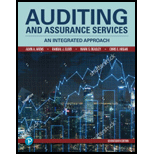
EBK AUDITING+ASSURANCE SERVICES
17th Edition
ISBN: 9780135171219
Author: ARENS
Publisher: PEARSON CO
expand_more
expand_more
format_list_bulleted
Question
Chapter 6, Problem 22.1MCQ
To determine
Indicate the option which defines fraud in auditing standards.
Expert Solution & Answer
Want to see the full answer?
Check out a sample textbook solution
Students have asked these similar questions
Ironforge Manufacturing, Inc., is a company that manufactures industrial equipment. During the year, Ironforge purchased $2,140,000 of direct materials and placed $1,970,000 worth of direct materials into production. Ironforge's beginning balance in the Materials Inventory account was $385,000. What is the ending balance in Ironforge's Materials Inventory account?
Kindly help me with this General accounting questions not use chart gpt please fast given solution
Please provide the accurate answer to this financial accounting problem using appropriate methods.
Chapter 6 Solutions
EBK AUDITING+ASSURANCE SERVICES
Ch. 6 - Prob. 1RQCh. 6 - Prob. 2RQCh. 6 - Prob. 3RQCh. 6 - Prob. 4RQCh. 6 - Prob. 5RQCh. 6 - Prob. 6RQCh. 6 - Prob. 7RQCh. 6 - What are the six elements of professional...Ch. 6 - What are the five elements of an effective...Ch. 6 - Describe two of the more common judgment traps and...
Ch. 6 - Identify the cycle to which each of the following...Ch. 6 - Why are sales, sales returns and allowances, bad...Ch. 6 - Prob. 13RQCh. 6 - Prob. 14RQCh. 6 - Prob. 15RQCh. 6 - Prob. 16RQCh. 6 - Prob. 17RQCh. 6 - Prob. 18RQCh. 6 - Prob. 19RQCh. 6 - Prob. 20RQCh. 6 - Prob. 21.1MCQCh. 6 - Prob. 21.2MCQCh. 6 - Prob. 21.3MCQCh. 6 - Prob. 22.1MCQCh. 6 - Prob. 22.2MCQCh. 6 - Prob. 22.3MCQCh. 6 - Prob. 23.1MCQCh. 6 - Prob. 23.2MCQCh. 6 - Prob. 23.3MCQCh. 6 - Prob. 24.1MCQCh. 6 - Prob. 24.2MCQCh. 6 - Prob. 24.3MCQCh. 6 - Prob. 25DQPCh. 6 - Prob. 26DQPCh. 6 - Prob. 27DQPCh. 6 - Prob. 28DQPCh. 6 - Prob. 29DQPCh. 6 - Prob. 30DQPCh. 6 - Prob. 31DQPCh. 6 - Prob. 32DQPCh. 6 - Prob. 33DQPCh. 6 - Prob. 34DQP
Knowledge Booster
Similar questions
- The actual cost of direct labor per hour is $29.75 and the standard cost of direct labor per hour is $31.20. The direct labor hours allowed per finished unit is 0.85 hours. During the current period, 7,500 units of finished goods were produced using 4,100 direct labor hours. How much is the direct labor rate variance?arrow_forwardPlease provide the accurate answer to this general accounting problem using appropriate methods.arrow_forwardMia Steel started the year with total assets of $325,000 and total liabilities of $174,000. During the year the business recorded $360,000 in revenues, $190,000 in expenses, and dividends of $99,000. Stockholders' equity at the end of the year was____.arrow_forward
arrow_back_ios
SEE MORE QUESTIONS
arrow_forward_ios
Recommended textbooks for you
 Auditing: A Risk Based-Approach to Conducting a Q...AccountingISBN:9781305080577Author:Karla M Johnstone, Audrey A. Gramling, Larry E. RittenbergPublisher:South-Western College Pub
Auditing: A Risk Based-Approach to Conducting a Q...AccountingISBN:9781305080577Author:Karla M Johnstone, Audrey A. Gramling, Larry E. RittenbergPublisher:South-Western College Pub Auditing: A Risk Based-Approach (MindTap Course L...AccountingISBN:9781337619455Author:Karla M Johnstone, Audrey A. Gramling, Larry E. RittenbergPublisher:Cengage Learning
Auditing: A Risk Based-Approach (MindTap Course L...AccountingISBN:9781337619455Author:Karla M Johnstone, Audrey A. Gramling, Larry E. RittenbergPublisher:Cengage Learning

Auditing: A Risk Based-Approach to Conducting a Q...
Accounting
ISBN:9781305080577
Author:Karla M Johnstone, Audrey A. Gramling, Larry E. Rittenberg
Publisher:South-Western College Pub

Auditing: A Risk Based-Approach (MindTap Course L...
Accounting
ISBN:9781337619455
Author:Karla M Johnstone, Audrey A. Gramling, Larry E. Rittenberg
Publisher:Cengage Learning
